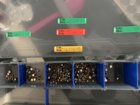@MikeMcCasland, great set of questions. Primer sorting may be an option. Test sorted versus unsorted and see what happens.
Few other thoughts. Do you use a reliable chrono while testing? I ask as that would be a good way to determine if your ES is not as tight as it could be, which would point towards primer inconsistencies or your powder node being slightly off (for a 20 shot string an ES of 20 or less is ideal).
if your ES is tight, your challenge might be position related while firing, scope magnification/mirage issues, or seating depth issues.
If your ES is not ideal, you could examine your brass prep and/or do a simple test at LR.
Load up 3 rounds per charge weight, in .1 grain increments surrounding your current load. For example, if your current node was 50.3, then load 50.1, 50.2, 50.3, 50.4, 50.5. Shoot them round robin at 1,000 yards to see if any of them sing for you (keep same POA and measure vertical dispersion...don’t worry about horizontal).
From direct experience I can share that @dmoran helped me tremendously in identifying positive compensation at 1,000 yards by tweaking my node up or down by a single .1 grain charge. It works miracles to test this!
Let us know what you find.
^this












